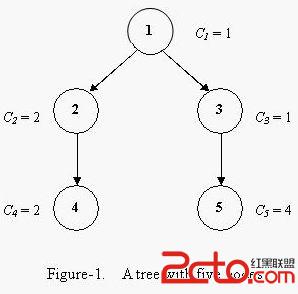HDU1055 POJ2054 Color a Tree
Color a Tree
Time Limit: 2000/1000 MS (Java/Others) Memory Limit: 65536/32768 K (Java/Others)
Total Submission(s): 1068 Accepted Submission(s): 349
Problem Description
Bob is very interested in the data structure of a tree. A tree is a directed graph in which a special node is singled out, called the "root" of the tree, and there is a unique path from the root to each of the other nodes.
Bob intends to color all the nodes of a tree with a pen. A tree has N nodes, these nodes are numbered 1, 2, ..., N. Suppose coloring a node takes 1 unit of time, and after finishing coloring one node, he is allowed to color another. Additionally, he is allowed
to color a node only when its father node has been colored. Obviously, Bob is only allowed to color the root in the first try.
Each node has a “coloring cost factor”, Ci. The coloring cost of each node depends both on Ci and the time at which Bob finishes the coloring of this node. At the beginning, the time is set to 0. If the finishing time of coloring node i is Fi, then the coloring
cost of node i is Ci * Fi.
For example, a tree with five nodes is shown in Figure-1. The coloring cost factors of each node are 1, 2, 1, 2 and 4. Bob can color the tree in the order 1, 3, 5, 2, 4, with the minimum total coloring cost of 33.

Given a tree and the coloring cZ喎?http://www.Bkjia.com/kf/ware/vc/" target="_blank" class="keylink">vc3QgZmFjdG9yIG9mIGVhY2ggbm9kZSwgcGxlYXNlIGhlbHAgQm9iIHRvIGZpbmQgdGhlIG1pbmltdW0gcG9zc2libGUgdG90YWwgY29sb3JpbmcgY29zdCBmb3IgY29sb3JpbmcgYWxsIHRoZSBub2Rlcy48YnI+CgogCjxicj4KSW5wdXQKVGhlIGlucHV0IGNvbnNpc3RzIG9mIHNldmVyYWwgdGVzdCBjYXNlcy4gVGhlIGZpcnN0IGxpbmUgb2YgZWFjaCBjYXNlIGNvbnRhaW5zIHR3byBpbnRlZ2VycyBOIGFuZCBSICgxIDw9IE4gPD0gMTAwMCwgMSA8PSBSIDw9IE4pLCB3aGVyZSBOIGlzIHRoZSBudW1iZXIgb2Ygbm9kZXMgaW4gdGhlIHRyZWUgYW5kIFIgaXMgdGhlIG5vZGUgbnVtYmVyIG9mIHRoZSByb290IG5vZGUuIFRoZSBzZWNvbmQgbGluZQogY29udGFpbnMgTiBpbnRlZ2VycywgdGhlIGktdGggb2Ygd2hpY2ggaXMgQ2kgKDEgPD0gQ2kgPD0gNTAwKSwgdGhlIGNvbG9yaW5nIGNvc3QgZmFjdG9yIG9mIG5vZGUgaS4gRWFjaCBvZiB0aGUgbmV4dCBOLTEgbGluZXMgY29udGFpbnMgdHdvIHNwYWNlLXNlcGFyYXRlZCBub2RlIG51bWJlcnMgVjEgYW5kIFYyLCB3aGljaCBhcmUgdGhlIGVuZHBvaW50cyBvZiBhbiBlZGdlIGluIHRoZSB0cmVlLCBkZW5vdGluZyB0aGF0IFYxIGlzIHRoZSBmYXRoZXIKIG5vZGUgb2YgVjIuIE5vIGVkZ2Ugd2lsbCBiZSBsaXN0ZWQgdHdpY2UsIGFuZCBhbGwgZWRnZXMgd2lsbCBiZSBsaXN0ZWQuIDxicj4KPGJyPgpBIHRlc3QgY2FzZSBvZiBOID0gMCBhbmQgUiA9IDAgaW5kaWNhdGVzIHRoZSBlbmQgb2YgaW5wdXQsIGFuZCBzaG91bGQgbm90IGJlIHByb2Nlc3NlZC4KPGJyPgoKIAo8YnI+Ck91dHB1dApGb3IgZWFjaCB0ZXN0IGNhc2UsIG91dHB1dCBhIGxpbmUgY29udGFpbmluZyB0aGUgbWluaW11bSB0b3RhbCBjb2xvcmluZyBjb3N0IHJlcXVpcmVkIGZvciBCb2IgdG8gY29sb3IgYWxsIHRoZSBub2Rlcy48YnI+CgogCjxicj4KU2FtcGxlIElucHV0Cgo8cHJlIGNsYXNzPQ=="brush:java;">5 1
1 2 1 2 4
1 2
1 3
2 4
3 5
0 0
Sample Output
33
Source
Asia 2004, Beijing (Mainland China)
參考
#include
#include
#define maxn 1002
struct Node{
int pre, c, t;
double w;
} V[maxn];
int findMax(int n, int root)
{
int i, u;
double maxv = -1;
for(i = 1; i <= n; ++i){
if(V[i].w > maxv && i != root){
maxv = V[i].w; u = i;
}
}
return u;
}
int main()
{
int n, root, i, ans, a, b, m, pre, j;
while(scanf("%d%d", &n, &root), n || root){
for(i = 1, ans = 0; i <= n; ++i){
scanf("%d", &V[i].c);
ans += V[i].c; V[i].t = 1;
V[i].w = V[i].c;
}
for(i = 1; i < n; ++i){
scanf("%d%d", &a, &b);
V[b].pre = a;
}
for(i = 1; i < n; ++i){
m = findMax(n, root);
V[m].w = 0; pre = V[m].pre;
ans += V[m].c * V[pre].t;
for(j = 1; j <= n; ++j)
if(V[j].pre == m) V[j].pre = pre;
V[pre].c += V[m].c;
V[pre].t += V[m].t;
V[pre].w = (double)V[pre].c / V[pre].t;
}
printf("%d\n", ans);
}
return 0;
}
